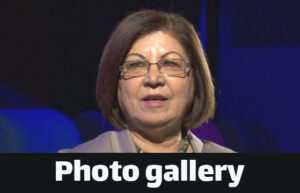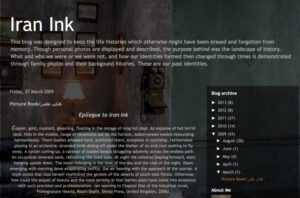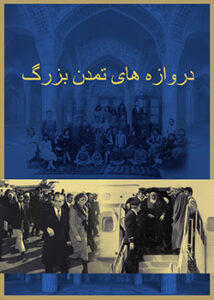The story of love in the classical Persian literature
Exile Ink Magazine
September 2008
“One story is, the story of love
yet, I hear it from every tongue
and all is different.”
In the classical Persian literature, the story of love and love stories have occupied a great space. Although in the ancient world, the realm of men and women were separated physically and regulated by strict codes and regulations, especially after the Arab invasion and the Islamisation of the country, classical Persian literature is full of depictive and enchanting love stories.
In Persia or Iran, up until the 20th century, poetry was the dominant language in literature. Through poetry, history, politics, social tensions, beauties of nature, human relations had been registered, described and depicted, sometimes in great detail by the Persian poets. Hakim Abulghasem Ferdowsi, (10th century AD) was one of the first poet/historians, who
spent thirty years of his life writing the history of the Iranian peoples before the Arab invasion in a book called Shahnameh,‘The Book of |Kings’, From the 10th century AD onwards, Persian literature took a new turn and great poets emerged and enriched the language. Rudaki, Hafiz and Sa’adi, Khayam, Rumi Nezami Ganjavi and many others; men and women wrote volumes of poetry depicting their personal lives and their world views and the society they lived.
On the subject of love and despite segregation and restrictions on pre-marital relationships between men and women, the work of these poets concentrates on some imaginary beloved or their sentimental feelings over separation and a burning desire for union. Yet, throughout the centuries, their works have also been interpreted to carry additional meaning; love for God or the creator or praise for the ruling king, who might otherwise have deprived the poet from writing freely. These masters of the Persian language managed to infuse images of love with numerous other meanings.
Persians and the Persian speaking people are devoted to poetry and to this day, prose has not been able to replace poetry to a great extent. It is through poetry that the “long, black tendril of her hair, the ghazal’s look-alike of the beloved’s eyes, the colour of her cheeks, her smile, her moon-lit face and her whole complexion comes to life and finds its way into classic miniatures and paintings through time. Dreaming of the beloved, a quick peep through the closed doors, depictions of the go-in-betweens or maybe simply the saghi girl, who serves wine from a tortoise goblet in the wine house; while in most cases, even the saghi girl being a young boy dressed as a girl!
Among the most famous poets, Hafiz (14th century AD) was able to remain as the master, who gave a new direction to Persian poetry. His book of poetry is kept to this date in every Persian speaking house and read and recited and sang and enjoyed generation after generation. Hafiz speaks freely of wine, love, nature and the beauty of the world:
“How priceless is the prayer-mat of piety,
they don’t accept it
for a cup of wine
in the street of wine-sellers.”
The great Sa’adi of Shiraz who was also contemporary to Hafiz had a smooth and musical language and spoke of love and longing in so many words:
“O, caravan, move slowly
the comfort of my soul is travelling with you.
My heart is departing with the owner of it.
How the soul departs from the body.
is the subject of many debates,
yet, I saw with my own eyes
the departure of my soul.”
Most of the love stories in the classical Persian literature had tragic endings. The poets reflected the society in which they lived and so, tragedy, longing, jealousy and revenge have a strong presence. Of the literature before the Arab invasion ( 6th and 7th century AD) little has remained. Nakisa and Barbad were among the poets known to have written poetry and to have sang them with musical instruments before the Invasion. Persian peoples, who were famous for their love of nature and beauty, when forced to accept the new religion, were also influenced by the strict culture it brought with it. There on, segregation brought with it longing, forbidden desires and the tragedies that ensued.
Against the restrictions placed on the Persian peoples, women occupy a big space in poetry and literature. In a book called “Famous Iranian and Persian peaking women from the earliest times to the Constitutional Revolution in early 20th century”, the author has recorded about 600 women poets, of whom very few had actually written love poems. The book only states the fact that women did not allow themselves to cross the line of piety and demonstrate their inner desires and love of the beloved. The majority of these women poets belonged to the courts or had connections with the kings and were supported by them as were men. These had either written poems in praise of the ruling king or God and creation, chastity, piety or religious themes. Daughters of a number of kings are also among women poets. A great number of these poets had studied Persian, Arabic and Koranic texts and mastered in such fields which originally belonged to men. Some poets had mentioned the subject of love, as part of praise of God, nature, humans, etc, others had dedicated hundreds of lines to depict true events in detail, reflecting the interaction between lovers and analysing the situation that surrounded the tragedy.
Among the first tragic love stories is Rabe’h, who is known to be the first woman poet registered in the history of Persian literature. Rabe’h was born in the 10th century AD, around the same time as Rudaki, the master of Persian poetry. They met on some occasions and exchanged their poems and Rudaki was very fond of Rabe’h. One historian has written: “although Rabe’h was a woman but her knowledge was superior to that of many learned men. She was the master of Persian and Arabic poetry.” According to some records, Rabe’h was a beautiful and gifted poet. When her father, Ka’ab died, Rabe’h’s brother, Hares, who was the Lord of Balkh, became her guardian. Rabe’h fell in love with one of her brother’s handsome slaves, Bektash. At this time, she secretly wrote poetry. Eventually, she became ill and weak and when a woman confidant insisted on the reason, she opened her heart. She then began to send her love poems to Bektash through this woman. Bektash also fell in love with Rabe’h. Some time later, Bektash was injured in the middle of a battlefield and story has it that as he was about to be taken prisoner, a clad warrior appeared on the scene and attacked the enemy fiercely, killing many and taking Bektash to safety. And so the army of Hares won the war.
Later, in a banquet in the court of King Amir Nasr Samani, in Bokhara, Rudaki recited a few of Rabe’h’s poetry. Legend has it that when Hares found out about the love between his sister and his warrior slave, enraged, he threw Bektash in a well and put Rabe’h in a bath, cutting her wrists and walling the bathroom door. And Rabe’h used her blood to write poems on the walls until the very last drop.
Mahasti Ganjavi (11th or 12 century AD), was among other gifted women poets, who wrote love poems some of which were even of an erotic nature. Of Mahasti’s work few have survived the centuries. According to the records she was a very beautiful and witty woman who had connections with the court of King Mahmoud Ghaznavi and later his nephew Sultan Sanjar. It is not known how Mahasti travelled from her hometown, Ganjeh to Marv and entered the King’s court. When very young, Mahasti fell in love with a man called Ahmad who became her husband or lover. One of her contemporaries, Jowhari Zargar had composed this love affair in a detailed poem.
“ I see him in rage with the cloud
I see him in search of sunshine.
If he is not the apple of my eye
why would I see him in water
whenever I look at him?”
Though tragedy is the essence of love stories in Persian literature, in the Book of Kings, Ferdowsi’s women are powerful, strong minded and influential in the political and social scenes. It must be mentioned that Ferdowsi’s recording of history is focused on pre-Islamic times and that might be one reason for the existence of such women in his epic work. According to one of his narrations, Sindokht was a legendary woman poet and the wife of Mehrab, the King of Kabul. She found out that her daughter, Rudabeh was in love with Za’l, Sam’s son, the Lord of Sistan, which was a province neighbouring Kabul and in constant war with it. Initially, she scorned her but having found out that they were deeply in love, she asked her husband to agree to their marriage. She then prepared presents, put on men’s costume and rushed to the court of Sam. Sindokht sat in conversation with Sam and told him of the love between Za’l and Rudabeh. Having heard of their true feelings, Sam took Sindokht’s hand and promised to agree with the marriage and never attack Kabul. Sindokht, who until then had not properly introduced herself told him who she was. Sindokht returned with caravans of presents and a friendly message for Mehrab.
This friendly relationship continued until Rostam, the legend hero in Shahnameh, the Book of Kings was born in Nimruz while Sindokht was at her daughter’s bedside. The love of Rudabeh and Sam is written in length in Shahnameh. Ferdowsi had registered a great many other love stories between the legends of Shahnameh. Women in the Book of Kings are strong, self-aware and directly approach the man they desire and tell them of their yearnings. Tahmineh, for example, found Rostam very handsome, when he came to the court of her father. At night, she went straight to his chambers and told him the facts. She told him who she was. Rostam married Tahmineh and she bore Sohrab, another legend in the Book of Kings. Almost all the love stories in Shahnameh end in marriage, while other Persian love stories have tragic consequences.
Up until the 20th century, writing of love and speaking about it was a disgrace for women poets. The emergence of Forugh Farokhzad, a young and courageous poet in the second part of the 20th century turned the pages of history and the concept of women speaking freely of love and their inner thoughts, entered Persian literature. Forugh wrote three books of poems. She was well aware that young women urged to free themselves of walls and veils and shout out their true desires:
“I want you and I know
that I can never take you in my arms;
you are like that clear, bright sky
and I am a captive bird in a cage.”
Forugh paid a high price for her rebellion. Her husband divorcedher and took away her only son. She was a divorcee at the age of nineteen. It was difficult to live freely among the hostile world which rejected such rebellion. Yet, Forugh chose to walk on that path and broke many traditional values, old social norms and hypocritical religious restrictions. To this date, none of the many Persian speaking women poets have replaced Forugh’s direct and strong language when it come to matters of human relations, love, loneliness, desire, companionship and liberation from restrictions;
“When you come to visit
my kind friend
bring a torch and a window
so that I can watch
the crowded alleyway of happiness.”
A great story with perfect rhyme and rhythm reflects in detail how love had been eternalised in Persian literature. Nezami Ganjgavi (11th century AD) was one of the great poets of all times. After he completed a collection of mystic poems, Nezami turned his attention from God and mysticism to earthly matters. He composed two lengthily love stories; Khosro & Shireen and another story, Leili & Majnoun. The first was written in remembrance of his beloved, Afagh, who died at a young age, and is briefly described below.
Khosro was a young prince who was about to become the King of Persia and Shireen was a princess in Armenia. She was to replace her aunt, Princess Mahin Banu as the ruler of that land. Shireen was a free woman, who mastered horse riding, hunting, playing polo and venturing out of town in search of adventure. Shahpour, a close friend and confidant of prince Khosro was a skilful painter and an artist as well. On one of his trips to Armenia, he found out that Shireen could be a potential wife to the future king. He painted the young, handsome prince on a canvas and hung it from a tree, near the hunting place, where he knew Shireen would notice. Shireen inquired about the painting and Shahpour explained in detail who he was. She fell in love with the painting and asked Shahpour to bring the young prince over to Armenia. The crown prince, having heard from Shahpour the beauty and the status of Shireen, decided to travel to Armenia and there he arrived at the court and was well received by Mahin Banu, who held many banquets in his honour. The prince felt at ease to go hunting with Shireen and her entourage and play polo with her and the two fell in love and decided to get married in due course.
Unfortunately, one night prince Khosro became very drunk and rushed to Shireen’s chambers and tried to impose himself on her. Shireen refused and the young prince’s pride was injured and he left Armenia in anger. On his way back to Persia he visited the king of Bizantine, where he was received with honour and the king proposed his daughter, Princess Maryam to him and he accepted the offer and married her. The prince knew well that he was still in love with Shireen but concealed his feelings. He took his bride home along with a squadron of the Bizantine army.
Shireen on the other hand, was heart broken. In the meantime, her aunt fell ill and died shortly afterwards. Shireen became Armenia’s ruler. The day Shireen heard of King Khosro Parviz’s crowning, she could not take it anymore. She appointed a deputy and set off for Tisfun, where the young king resided, taking with her a wealth of goods and courtiers and set camp outside town. King Khosro on the other hand was delighted to hear that his beloved had come such long way to be near him but Queen Maryam forbade him to visit Shireen. The two lovers kept exchanging messages through Shahpour but Shireen refused to become the King’s lover.
Nezami had written many lines, depicting these letters, here talking of the lovers anger, despair, frustration, blaming each other, there flirtatious pleasantries, longing to embrace, complaining of separation and the circumstances they had to endure.
“ Tell the king that if he claims he loves me
I would not be flattered.
And if he asks when he would have Shireen
tell him he has to satisfy himself with Maryam.”
Then a tender language;
“When you see the King, give him a message for me.
Tell him
Your are the one who broke the promise and
forgot the sweet covenant we had.
Tell him
I believed he would not turn away from me and
will not choose another woman.
Tell him
If I am not warm by the fire of his love
I am warm in the shadow of its smoke.”
While setting a permanent camp, Shireen found out that in the meadows around her camp there grew some poisonous plants which prevented the sheep to graze and so she sent the flock of sheep high into the mountain. To bring the milk down was a hard job and Shireen aimed to ask a stone cutter to cut a path from above so the milk flows down to her camp. Shahpour found an engineer called Farhad and brought him to Shireen’s court to discuss the matter. Farhad fell in love with Shireen instantly and accepted to begin the work immediately. The painstaking work of carving a brook through hard rocks continued by the power of Farhad’s love for Shireen and completed in no time. Shireen paid a visit to Bisotun Kooh (Mountain Bisotun) and praised Farhad for the monumental job he had done and invited him to her court and introduced him to her courtier, giving him a substantial amount of gold. Farhad on the other hand, was intoxicated to be in Shireen’s presence. By now, King Khosro Parviz and the whole town were aware of Farhad’s intense love for Shireen. The King felt the presence of a rival and upon the insistence of his confidants summoned Farhad to the court and promised him a high position as an artist and much wealth. But Farhad was not the man to be patronised and bribed by the King. He left the court and went straight to the mountain and began carving a path through the hard rocks. People would gather at the feet of the mountain and watch him at work while Farhad was busy breaking the rocks and thinking of his beloved. One day Shireen travelled to the mountain to watch Farhad at work and gave him a goblet of milk. Farhad was intoxicated by this gesture and found new energy to continue. King Khosro on the other hand, having heard of Shireen’s visit was enraged by jealousy and called on his confidants to seek a way to rid of Farhad.
One day a messenger rushed to the mountain and informed Farhad of Shireen’s sudden death. The unfortunate lover, having heard of such terrible news took the hammer and hacked himself with one stroke. As Shireen heard the news she was very sad and ordered a full ceremony for Farhad’s funeral and mourned the unfortunate young man’s death.
King Khosro Parviz, who regretted what he had done, wrote a letter of consolation to Shireen and blamed her for mourning Farhad’s death. Shortly afterwards, Queen Maryam fell ill and died. In response to the letter she received from the King, Shireen wrote a letter of consolation to him. The turbulent relations between the two old lovers took a long time to heal. The king declined to marry Shireen and wanted her to be his lover. Shireen refused that and so they remained in love but far apart.
Nezami Ganjavi had written hundreds of lines depicting details of conversations and messages between the two lovers. His language is to this date poetic, argumentative and strong. Both lovers have a strong personality. None is willing to give way to the other. Here they are angry at each other, there they reconcile and make amends. Shireen loves to flirt and keep the fire of desire alive. The King is mad with lust and love and on several occasions rushes to Shireen’s court and urges to make love to her. Shireen is a strong woman and although deeply in love with Khosro Parviz, does not sacrifice her honour and her dignity to become his lover.
One night, the King dreams that he had made love to Shireen and Shahpour promises him that his dream would soon come true. The king orders a state banquette and invites Barbad and Nakisa, two well-known singers to perform in front of the guests. The voice of the singers and the music is so intoxicating that Shireen begins to sing with them from a tent nearby. The King loses control and begins to sing with her and runs to her tent. Separation ends and the two lovers stop their games and in a week-long celebration they finally get married. Eventually, Shahpour is appointed the ruler of Armenia to replace Shireen. King Khosro Parviz and Queen Shireen ruled Persia for many years until he was old and turned to religion and moved to a temple. Shireen moved with her husband to the temple and put herself at his service.
At this time, Shiruyeh, King Khosro Parviz’s son from his marriage to Maryam topples his father from the throne and declares himself King. He takes the King away from the temple and puts him in prison. Shireen accompanies Khosro and stays with him, day and night while nursing him. On the other hand, Shiruyeh conspires to kill his own father and take Shireen by force. He enters the prison and cuts his father’s side with a sword. Shireen who was asleep opens her eyes and sees her beloved in a pool of blood. Devastated, she arranges for a state funeral and herself in official mourning dress walks along side the coffin. As they lower the body to the ground, Shireen bends to kiss her husband and quickly draws a sword to kill herself at his feet.
As all epic love stories, Khosro and Shireen’s story ends in tragedy but today if you travel to the west of Iran, Bisotun Mountain bears Farhad’s carvings and is one of the many tourist attractions in the country..
Bibliography;
1- Modern Persian Poetry,Mahmud Kianush, 1996, The rockingham Press, UK
2- Well-known Women Poets from the Earliest Times to the Constitutional. Revolution, Mohammand Hassan Rajabi, 1995, Sorush Pub;ications, Tehran, Iran.
3- The Anatomy of Two Women in Nezami Ganjavi’s Poetry, Saidi Sirjani, 1988, Nashr Now, Tehran, Iran








